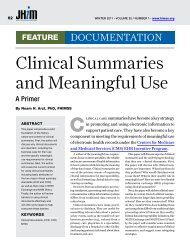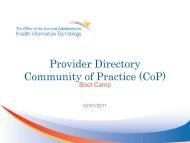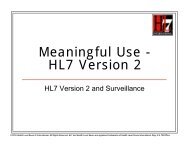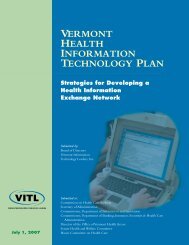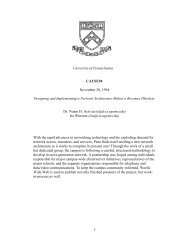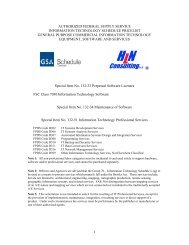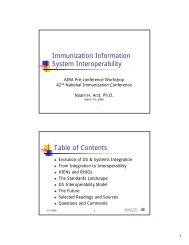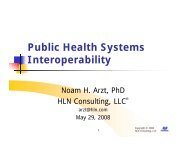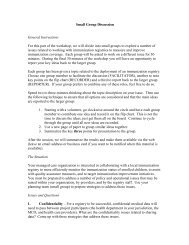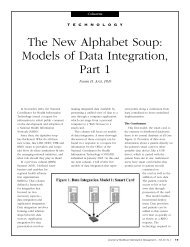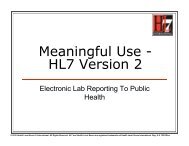Models for Regional Health Information Organization (RHIO ...
Models for Regional Health Information Organization (RHIO ...
Models for Regional Health Information Organization (RHIO ...
Create successful ePaper yourself
Turn your PDF publications into a flip-book with our unique Google optimized e-Paper software.
<strong>Models</strong> <strong>for</strong> <strong>Regional</strong> <strong>Health</strong><br />
In<strong>for</strong>mation <strong>Organization</strong><br />
(<strong>RHIO</strong>) Systems<br />
National Association <strong>for</strong> Public <strong>Health</strong> In<strong>for</strong>mation Technology<br />
Webinar: March 15, 2006<br />
Noam H. Arzt, Ph.D.<br />
HLN Consulting, LLC<br />
858/538-2220 arzt@hln.com<br />
3/15/2006 1<br />
Agenda<br />
• <strong>RHIO</strong> Definition<br />
• Integration Framework<br />
• Data Integration <strong>Models</strong><br />
• Application Integration <strong>Models</strong><br />
• <strong>RHIO</strong>-Public <strong>Health</strong> Issues<br />
3/15/2006 2
<strong>RHIO</strong> Definition<br />
3/15/2006 3<br />
3/15/2006 4<br />
What is a <strong>RHIO</strong><br />
• No single definition – in the eye of the beholder<br />
• A collaborative organization focused on health data<br />
exchange<br />
• Participants: Physicians, labs, hospitals, pharmacies,<br />
patients, public health, payers<br />
• Primarily driven by the private sector, but often has<br />
public health involvement (and may be driven by the<br />
public sector)<br />
• Usually focused on clinical data exchange, but may<br />
focus on health services data in addition or instead<br />
(<strong>Health</strong> In<strong>for</strong>mation Exchange Networks - HIEN)<br />
• Can span a metropolitan area, region, or a state
<strong>Health</strong> In<strong>for</strong>mation Exchange<br />
Network (HIEN)<br />
3/15/2006 5<br />
Enablers of <strong>RHIO</strong> Development<br />
• Interest and Momentum – Is it enough<br />
• Standards – March continues on<br />
• Public <strong>Health</strong> Expertise – Leverage possible<br />
• The Internet – Pervasive and ubiquitous<br />
3/15/2006 6
Barriers to <strong>RHIO</strong> Development<br />
• Financial – Need strong business case<br />
• Standards – Not fully developed<br />
• Identification – No national patient identifier<br />
• Authentication – Of participants<br />
• <strong>Organization</strong>al – Public-private boundaries<br />
• Vocabulary and Terminology – Language<br />
• Technology – Limited interoperability<br />
3/15/2006 7<br />
The <strong>RHIO</strong> Conundrum:<br />
Should you develop a discreet technical<br />
architecture first, then solicit proposals<br />
to build it<br />
Or should you leave the architecture up<br />
to the vendors who propose solutions to<br />
meet your needs<br />
3/15/2006 8
The <strong>RHIO</strong> Conundrum<br />
Favor pre-determination:<br />
• Concerned about ability to<br />
weigh alternatives<br />
• Less confident about<br />
funders’ commitment<br />
• Unique opportunity to<br />
leverage technology<br />
• More certain about COTS<br />
• Participants less flexible<br />
<strong>for</strong> data sharing<br />
Favor more open-ended:<br />
• Concerned about<br />
perceptions of bias<br />
• Consensus around clearlyarticulated<br />
requirements<br />
• More interested in<br />
innovation than mitigating<br />
technical risk<br />
• Less certain about existing<br />
solutions<br />
• Participants more capable<br />
<strong>for</strong> data sharing<br />
3/15/2006 9<br />
Types of Integration<br />
3/15/2006 10
Two Types of Integration<br />
• Data Integration: <strong>for</strong>ming valid<br />
relationships between data sources<br />
• Application Integration: presenting a<br />
unified view of data to a user through a<br />
computer application<br />
3/15/2006 11<br />
Data versus Application Integration<br />
Direct Access Application<br />
Application<br />
Integration<br />
“The System”<br />
User Access Through<br />
Existing Local<br />
Application<br />
Data<br />
Integration<br />
Participating Data Sources<br />
3/15/2006 12
Data and Application Integration<br />
The message:<br />
– These are two parts of the same puzzle<br />
– Perceptions about “ease of access” and “ease of<br />
use” have to be viewed based on assumptions<br />
about these two types of integration<br />
– Issue of timely access to/submission of data is<br />
critical to all strategies<br />
3/15/2006 13<br />
Data Integration <strong>Models</strong><br />
3/15/2006 14
Five <strong>Models</strong><br />
Model 1: Smart Card<br />
Features:<br />
•Extreme in distributed databases: no central database at all!<br />
•Providers of data store in<strong>for</strong>mation directly onto a patient’s smart card<br />
which is carried from site to site<br />
•Authorized users have smart card readers which permit access to<br />
records<br />
•Patient controls access to data through possession of the card<br />
•Patients do not typically have card readers of their own<br />
3/15/2006 15<br />
Five <strong>Models</strong><br />
Model 1: Smart Card (continued)<br />
Strengths:<br />
•Allows incremental deployment<br />
as participants are ready<br />
•Relatively inexpensive<br />
technology<br />
•No burden of central<br />
coordination<br />
•No dependence on a central<br />
database<br />
•No difficult requirements <strong>for</strong><br />
data consolidation<br />
•May be less expensive to<br />
deploy<br />
Limitations:<br />
•Patient must be physically<br />
present (or the card must be<br />
present) to access data<br />
•Data is replicated from<br />
provider system to smart card<br />
and can become<br />
unsynchronized<br />
•Provider system must be able<br />
to accommodate smart card;<br />
high integration cost<br />
•Does not facilitate system-wide<br />
data analysis<br />
3/15/2006 16
Five <strong>Models</strong><br />
Model 2: Peer to Peer<br />
Targeted<br />
Broadcast<br />
Facilitated<br />
Features:<br />
•No central data server required, but directory server (of providers, not<br />
patients) can be used to facilitate communications<br />
•Each system communicates as needed with neighboring systems<br />
•Data is displayed within each users “local” system, or stored locally<br />
•Queries between systems could be targeted or “broadcast”<br />
•Standard <strong>for</strong> communications (e.g., HL7) both <strong>for</strong> data <strong>for</strong>mats, message<br />
types, and communications techniques<br />
•Can support real-time messaging or batch communications depending on<br />
the capabilities of the participating systems<br />
3/15/2006 17<br />
Five <strong>Models</strong><br />
Model 2: Peer to Peer (continued)<br />
Strengths:<br />
• Allows incremental deployment<br />
as systems are ready<br />
• No replication of data required<br />
(though it is possible)<br />
• Any system can participate (even<br />
geographically peripheral) if they<br />
adopt the standards<br />
• Lower burden of central<br />
coordination<br />
• No dependence on a central<br />
database (except <strong>for</strong> Facilitated)<br />
• May work well when number of<br />
participants is small<br />
• May be less expensive to deploy<br />
Limitations:<br />
• In some implementations, need to<br />
know the destination system <strong>for</strong><br />
your in<strong>for</strong>mation request, or be<br />
patient while “the network” is<br />
searched<br />
• Might allow some systems to fall<br />
behind and not support intersystem<br />
communication<br />
• Will not scale well to many,<br />
many systems<br />
• Does not facilitate system-wide<br />
data analysis<br />
• Per<strong>for</strong>mance may be slow<br />
3/15/2006 18
Five <strong>Models</strong><br />
Model 2: Peer to Peer (continued)<br />
Typical In<strong>for</strong>mation Flow: Facilitated Model<br />
3/15/2006 19<br />
Five <strong>Models</strong><br />
Model 3: In<strong>for</strong>mation Broker<br />
Features:<br />
• Central hub operated by regional authority, public or private<br />
• Hub contains master index of all patients contained in all participating systems but does not<br />
contain any actual clinical records<br />
• Each participating system is flagged in the index as possessing data <strong>for</strong> a particular patient<br />
• A participating system queries the hub to identify where parts of a patient’s record exist<br />
elsewhere, then either queries those systems directly. Alternatively, a user accesses patient<br />
records through a central “hub application.”<br />
• Community-wide standard <strong>for</strong> communications (e.g., HL7) both <strong>for</strong> data <strong>for</strong>mats, message<br />
types, and communications techniques<br />
• Can support real-time messaging or batch communications<br />
3/15/2006 20
Five <strong>Models</strong><br />
Model 3: In<strong>for</strong>mation Broker (continued)<br />
Strengths:<br />
• System can discover where relevant<br />
records are housed community-wide<br />
• No replication of clinical data; data<br />
remains close to its source<br />
• System as a whole better protected from<br />
inappropriate disclosure (systems can<br />
refuse a query)<br />
• Scales well<br />
• Facilitates system-wide data analysis<br />
• May be easier to incrementally add<br />
participating systems<br />
Example:<br />
New York City MCI<br />
MA-SHARE<br />
Limitations:<br />
• Strong central coordination required<br />
• Dependence on the central hub <strong>for</strong> intersystem<br />
communications<br />
• Harder <strong>for</strong> individual systems to participate<br />
• Requires two steps (and more time) to get<br />
data: query to the hub, then second query to<br />
the authoritative system<br />
• Potential <strong>for</strong> large ef<strong>for</strong>t to keep demographic<br />
records free from duplication<br />
• Other systems may be unavailable at query<br />
time<br />
• More difficult to present a coherent, unified<br />
view of the patient<br />
3/15/2006 21<br />
Five <strong>Models</strong><br />
Model 4: Partitioned Warehouse<br />
Features:<br />
• Central database operated by the regional authority which assembles complete,<br />
consolidated record of people and their medical data (similar to Model 3), but<br />
assembled “on the fly” from separately-maintained “vaults”<br />
• Central database contains master index of all patients contained in all participating<br />
systems (similar to Model 2)<br />
• Systems required to periodically supply data to the central database cluster<br />
• Standard <strong>for</strong> communications (e.g., HL7) both <strong>for</strong> data <strong>for</strong>mats, message types, and<br />
communications techniques<br />
• Can support real-time messaging or batch communications depending on the<br />
capabilities of the participating systems<br />
3/15/2006 22
Five <strong>Models</strong><br />
Model 4: Partitioned Warehouse (continued)<br />
Strengths:<br />
• Less real-time dependence on other<br />
participating systems<br />
• Implements a stricter “need to know”<br />
policy <strong>for</strong> data access<br />
• Facilitates system-wide data analysis<br />
• Scales well so long as appropriate<br />
investments made in central<br />
resources<br />
Example:<br />
Indianapolis Network <strong>for</strong><br />
Primary Care<br />
Limitations:<br />
• Strong central coordination required<br />
• Dependence on large central database <strong>for</strong><br />
inter-system queries<br />
• Queries may take longer to fulfill due to “on<br />
the fly” data consolidation<br />
• Data timeliness issue: data submission from<br />
participating systems to central database may<br />
lag<br />
• Potential <strong>for</strong> large ef<strong>for</strong>t to keep people and<br />
clinical records free from duplication<br />
• Harder to implement incrementally<br />
• Requires timely submission of data to be<br />
effective<br />
• Unclear how to implement large number of<br />
vaults <strong>for</strong> small providers<br />
• Likely fairly expensive option<br />
3/15/2006 23<br />
Five <strong>Models</strong><br />
Model 5: Central Warehouse<br />
Features:<br />
• Central database operated by the regional authority which contains complete,<br />
consolidated record of all people and their medical data: a "union catalog"<br />
• Systems required to periodically supply data to the central database<br />
• Standard <strong>for</strong> communications (e.g., HL7) both <strong>for</strong> data <strong>for</strong>mats, message types,<br />
and communications techniques<br />
• Can support real-time messaging or batch communications depending on the<br />
capabilities of the participating systems<br />
3/15/2006 24
Five <strong>Models</strong><br />
Model 5: Central Warehouse (continued)<br />
Strengths:<br />
• Querying system’s response to a data<br />
request is quicker<br />
• Less real-time dependence on other<br />
participating systems<br />
• Facilitates system-wide data analysis<br />
• Scales well so long as appropriate<br />
investments are made in central resources<br />
• Economies of scale due to use of largescale<br />
central resources<br />
• Likely better expertise in managing<br />
central resources<br />
• Supports existing systems well<br />
Example:<br />
Arizona <strong>Health</strong>Query<br />
TN MidSouth<br />
e<strong>Health</strong> Alliance<br />
3/15/2006 25<br />
Limitations:<br />
• Strong central coordination required<br />
• Dependence on large central database <strong>for</strong><br />
inter-system queries<br />
• Data timeliness issue: data submission from<br />
participating systems to central database<br />
may lag<br />
• Potential <strong>for</strong> large ef<strong>for</strong>t to keep people and<br />
clinical records free from duplication<br />
• Potential <strong>for</strong> inappropriate disclosure as<br />
medical data from unrelated system joined<br />
together in advance of specific query or<br />
need<br />
• Harder to implement incrementally and<br />
provide complete data<br />
• Requires timely submission of data to be<br />
effective<br />
• Likely fairly expensive option<br />
Relative Model Strength<br />
Ease of Use<br />
Timeliness<br />
3<br />
2<br />
1<br />
0<br />
Reliability<br />
Peer to Peer<br />
Info Broker<br />
Warehouse<br />
Comprehensiveness<br />
Ease of use is<br />
in the eye of<br />
the beholder!<br />
3/15/2006 26
Date Source vs Data Use Profile<br />
3/15/2006 27<br />
Strategy Comparison<br />
3/15/2006 28
Application Integration <strong>Models</strong><br />
3/15/2006 29<br />
Four <strong>Models</strong><br />
Model 1: Independent Application<br />
• Users access data through a new computer application provided as part of<br />
the system, sometimes referred to as a “portal”<br />
• No concerns about interoperability with other applications<br />
But<br />
• Users may become confused about which application to use<br />
• Some organizations may not want to support this additional, noninstitutional<br />
application, and may discourage its use or ban it altogether<br />
3/15/2006 30
Four <strong>Models</strong><br />
Model 2: Data Exchange/Local<br />
Application<br />
• User’s local system queries the central system through a standard<br />
protocol (e.g., HL7) and data is displayed within the user’s local<br />
application<br />
• No concern about user confusion – all data accessed through familiar,<br />
supported local applications<br />
But<br />
• Systems must support agreed-upon method <strong>for</strong> query and response<br />
• Network interruption or latency can interfere or degrade per<strong>for</strong>mance<br />
3/15/2006 31<br />
Four <strong>Models</strong><br />
Model 3: Direct Access through<br />
Local Application<br />
• User’s access patients in the local system which initiates a login to the<br />
central system through a standard protocol (e.g., CCOW) and logs the<br />
user into the central system with existing credentials and query<br />
parameters<br />
• User access data both with local system and central system but does not<br />
have to re-query or re-authenticate<br />
But<br />
• Network interruption or latency can still interfere or degrade per<strong>for</strong>mance<br />
3/15/2006 32
Four <strong>Models</strong><br />
Model 4: Data Access via Smart Card<br />
• Data stored directly on smart card which then has consolidated record<br />
But<br />
• Providers may not be able to readily write to the card nor integrate data<br />
easily into their other applications<br />
3/15/2006 33<br />
<strong>RHIO</strong>-Public <strong>Health</strong> Issues<br />
3/15/2006 34
Integration Roadmap:<br />
Public <strong>Health</strong> Perspective<br />
3/15/2006 35<br />
What Can Public <strong>Health</strong> Contribute<br />
to a <strong>RHIO</strong><br />
• “Quick start” by leveraging existing activities<br />
• Data, including consolidated data<br />
• Expertise: registries, de-duplication, database<br />
management, web applications, data exchange including<br />
HL7<br />
• Existing relationships with many relevant stakeholders:<br />
providers, hospitals, payers, professional associations<br />
• Governance: experience in negotiating and implementing<br />
data sharing agreements<br />
• Childhood health data somewhat more contained and<br />
manageable than adult health data<br />
3/15/2006 36
National Scene<br />
• American <strong>Health</strong> In<strong>for</strong>mation Community<br />
(AHIC)<br />
• Office of the National Coordinator <strong>for</strong> HIT<br />
(ONC)<br />
• <strong>Health</strong> In<strong>for</strong>mation Technology Standards<br />
Panel (HITSP)<br />
• Certification Commission <strong>for</strong> <strong>Health</strong>care<br />
In<strong>for</strong>mation Technology (CCHIT)<br />
3/15/2006 37<br />
Selected Sources<br />
• CCHIT: http://www.cchit.org/<br />
• Connecting <strong>for</strong> <strong>Health</strong> (Markle Foundation):<br />
http://www.connecting<strong>for</strong>health.org/<br />
• e<strong>Health</strong> Initiative:<br />
http://www.ehealthinitiative.org/<br />
• HITSP: http://www.hitsp.org/<br />
• HL7: http://www.hl7.org/<br />
• HLN: http://www.hln.com/resources/rhio.php<br />
• ONC: http://www.hhs.gov/healthit/<br />
3/15/2006 38
Questions<br />
3/15/2006 39



